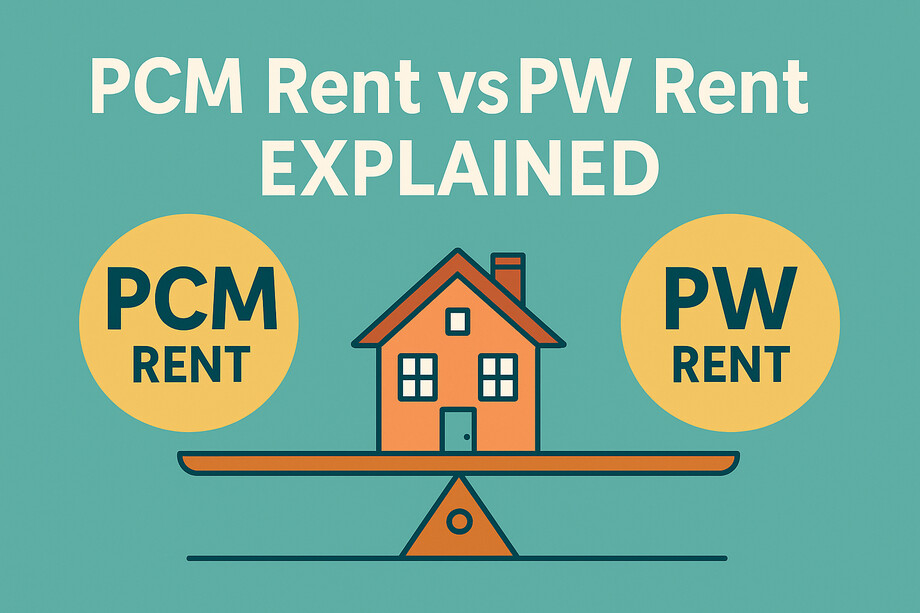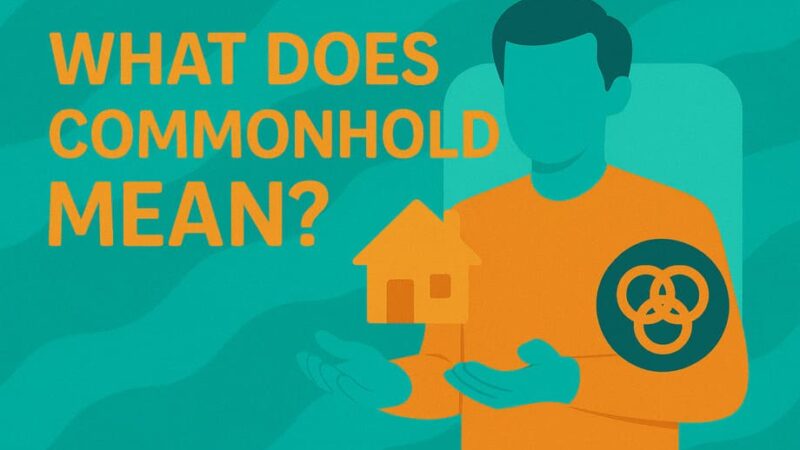PCM Rent vs PW Rent Explained: Your Complete Guide to UK Rental Pricing

PW in rent means “per week.” It shows the weekly rental cost of a property in the UK instead of monthly. For example, £300 pw ≈ £1,300 pcm (per calendar month). Alongside PW, you’ll often see PCM (per calendar month), both terms are essential for comparing rental listings, budgeting, and making informed property decisions. This guide explains exactly what PCM and PW mean, how to convert between them, and when each is commonly used.
Rental Jargon at a Glance
| Term | Meaning | Common Use |
|---|---|---|
| PW | Per Week – rent is quoted weekly. | Student lets, short-term rentals, HMOs. |
| PCM | Per Calendar Month – rent is quoted monthly. | Standard residential lettings. |
| PPPW | Per Person Per Week. | Student accommodation and shared houses. |
| PA | Per Annum – rent is quoted yearly. | Commercial or long-term tenancy agreements. |
What Does PCM Mean in Rent?
PCM stands for “Per Calendar Month“ and represents the total monthly rental cost for a property. This is the most common way rental prices are advertised across the UK, particularly for long-term residential lettings.
When a property is listed at £1,200 PCM, this means you’ll pay £1,200 every calendar month, regardless of whether that month has 28, 30, or 31 days. This pricing method provides consistency and predictability for both tenants and landlords.
How PCM Rent Works
PCM rent operates on a straightforward monthly basis:
- Rent is typically due on the same date each month
- The amount remains constant regardless of the month’s length
- Most tenancy agreements specify PCM as the standard payment structure
- Standing orders and direct debits are easily set up for monthly payments
What Does PW Mean in Rent?
PW stands for “Per Week” and indicates the weekly rental cost for a property. While less common for standard residential lettings, PW pricing is frequently used in specific market segments and geographical areas.
A property advertised at £300 PW means you would pay £300 every week, totalling approximately £1,300 per month (£300 × 52 weeks ÷ 12 months = £1,300).
When PW Rent is Commonly Used
Weekly rent pricing appears most frequently in:
- Student accommodation and house shares
- Short-term and holiday lettings
- Certain regional markets, particularly in northern England
- Properties targeting tenants paid weekly
- Rooms in shared houses or HMOs (Houses in Multiple Occupation)
Converting Between PCM and PW Rent
Understanding how to convert between these pricing methods is crucial for accurate property comparisons.
Converting PW to PCM
Weekly to Monthly Rent
Weekly to Monthly Rent Conversion
UK rental conversion reference table
Example: £200 weekly × 52 ÷ 12 = £867 monthly
| Weekly Rent (PW) | Monthly Rent (PCM) |
|---|
Converting PCM to PW
Monthly to Weekly Rent
Monthly to Weekly Rent Conversion
UK rental conversion reference table
Example: £867 monthly × 12 ÷ 52 = £200 weekly
| Monthly Rent (PCM) | Weekly Rent (PW) |
|---|
Quick Reference Multipliers
For faster calculations:
- PW to PCM: Multiply weekly rent by 4.33
- PCM to PW: Multiply monthly rent by 0.23
Need exact figures? Try our Weekly to Monthly Rent Calculator for instant conversions tailored to your rent.
Key Differences Between PCM and PW Rent
Payment Frequency
The most obvious difference lies in payment schedules:
- PCM: Payments made monthly, typically on the same date
- PW: Payments made weekly, usually on the same day of the week
Budgeting Implications
Each system affects personal budgeting differently:
- PCM: Aligns with monthly salary payments and most household bills
- PW: Suits those paid weekly or who prefer smaller, frequent payments
Market Positioning
Different pricing methods target different market segments:
- PCM: Standard for professional rentals and family homes
- PW: Common in student markets and flexible accommodation
Advantages of PCM Rent
Simplified Monthly Budgeting
PCM rent offers several budgeting benefits:
- Aligns perfectly with monthly salary payments
- Matches the billing cycle of utilities and other household expenses
- Easier to track and manage within monthly budget frameworks
- Reduces the number of rent payments from 52 to 12 per year
Reduced Administrative Burden
Monthly payments create operational advantages:
- Fewer bank transactions to monitor
- Simplified record-keeping for both tenants and landlords
- Less frequent payment processing requirements
- Easier integration with financial planning tools
Professional Market Standard
PCM pricing is the established norm for:
- Professional rental markets
- Long-term residential tenancies
- Properties targeting working professionals
- Family homes and larger properties
Advantages of PW Rent
Flexibility for Irregular Income
Weekly rent suits certain financial situations:
- Ideal for those with weekly pay cycles
- Better for irregular or variable income streams
- Allows for more frequent payment adjustments
- Provides psychological comfort of smaller individual payments
Student and Shared Accommodation Benefits
PW rent works particularly well for:
- Student lets that may not align with calendar months
- Flexible accommodation arrangements
- Short-term stays and transitional housing
- House shares with varying occupancy patterns
Regional Market Preferences
Some geographical areas favour weekly pricing:
- Traditional in certain northern English markets
- Established practice in specific local rental markets
- Cultural preferences for weekly payment cycles
- Historical precedent in certain property types
Which Pricing Method Should You Expect?
Property Type Indicators
The type of accommodation often determines pricing method:
PCM Properties:
- One and two-bedroom flats
- Family houses
- Professional accommodation
- Purpose-built developments
- Luxury and high-end rentals
PW Properties:
- Student houses and rooms
- Shared accommodation
- Holiday lets and short-term rentals
- Bedsits and studio apartments
- HMO properties
Geographical Variations
Regional preferences influence pricing methods:
- London and South East: Predominantly PCM
- Northern England: More PW pricing, especially in traditional markets
- Student Cities: Mixed, depending on target market
- Scotland: Generally PCM for standard lettings
Financial Planning with PCM vs PW Rent
Annual Rent Calculations
Understanding total annual costs is crucial:
- PCM: Monthly rent × 12 = Annual cost
- PW: Weekly rent × 52 = Annual cost
Budgeting Strategies
Different approaches suit different pricing methods:
For PCM Properties:
- Align rent payment with salary date
- Set up monthly standing orders
- Plan other monthly expenses around rent payment
- Use monthly budgeting apps and tools
For PW Properties:
- Consider setting aside money weekly
- May need to plan for months with five payment weeks
- Ensure consistent weekly income to cover payments
- Consider the impact of bank holidays on payment schedules
Legal Considerations and Tenancy Agreements
Tenancy Agreement Specifications
Your tenancy agreement should clearly state:
- Whether rent is PCM or PW
- Specific payment due dates
- Consequences of late payment
- How rent increases will be calculated and applied
Rent Increase Implications
The pricing method affects how increases are applied:
- PCM: Increases typically applied to monthly amount
- PW: Increases applied to weekly rate, affecting annual total differently
Deposit Calculations
Security deposits may be calculated differently:
- Often equivalent to 1-6 weeks’ rent regardless of pricing method
- PCM properties might require monthly deposit equivalent
- Legal maximums apply regardless of pricing structure
Common Pitfalls and How to Avoid Them
Comparison Mistakes
Avoid these common errors when comparing properties:
- Don’t compare PCM and PW figures directly
- Always convert to the same timeframe for accurate comparison
- Consider total annual costs rather than just monthly/weekly amounts
- Account for additional fees and charges in your calculations
Payment Schedule Confusion
Prevent payment issues by:
- Clearly understanding your payment frequency obligations
- Setting up appropriate payment methods
- Planning for months with different payment requirements
- Maintaining clear records of payment dates and amounts
Hidden Cost Considerations
Look beyond the headline rent figure:
- Factor in utility costs and council tax
- Consider additional fees and charges
- Account for deposit requirements
- Include potential rent increases in long-term planning
Tips for Tenants: Making the Right Choice
Assess Your Financial Situation
Consider these factors when evaluating PCM vs PW properties:
- Your salary payment frequency
- Budgeting preferences and habits
- Cash flow management needs
- Long-term financial planning style
Property Comparison Strategy
Make fair comparisons by:
- Converting all rents to annual figures
- Comparing total occupancy costs
- Considering location and transport costs
- Evaluating included amenities and services
Negotiation Considerations
When discussing terms with landlords:
- Understand which pricing method offers better value
- Consider requesting alternative payment structures
- Factor pricing method into deposit negotiations
- Clarify any flexibility in payment schedules
The Future of Rental Pricing in the UK
Market Trends
Several trends are shaping rental pricing:
- Increasing standardization towards PCM pricing
- Technology enabling more flexible payment options
- Growing demand for transparent, all-inclusive pricing
- Regional variations likely to persist
Technology Impact
Modern rental platforms are:
- Making price comparisons easier across different structures
- Offering automated conversion tools
- Enabling flexible payment scheduling options
- Providing better budgeting and financial planning tools
What does PW mean in rent?
PW stands for “per week.” It shows the weekly rental cost of a property in the UK.
How do I convert PW rent to PCM rent?
Multiply the weekly rent by 52 and divide by 12. For example, £300 pw ≈ £1,300 pcm.
What is the difference between PW and PCM in rent?
PW = per week. PCM = per calendar month. PCM is more common in UK rental listings.
What does PPPW mean in rent?
PPPW means “per person per week,” often used in student and shared housing.
Is PW rent cheaper than PCM?
Not necessarily. They are just different ways of quoting rent — always convert to the same timeframe to compare properly.
Conclusion
Understanding the difference between PCM and PW rent is fundamental to successful property hunting and rental management in the UK. While PCM remains the dominant pricing method for most residential properties, PW pricing continues to serve specific market segments effectively.
Now that you understand the difference between PCM and PW rent, you can easily convert between the two using our weekly to monthly rent calculator for accurate conversions.
The key to making informed decisions lies in understanding your own financial situation, converting between pricing methods for accurate comparisons, and recognizing which approach best suits your circumstances. Whether you encounter PCM or PW pricing, the most important factor is the total annual cost and how it fits within your overall budget.
Remember to always convert rental prices to a common timeframe when comparing properties, consider the total cost of occupation including all fees and charges, and choose the payment structure that best aligns with your income and budgeting preferences. By understanding these fundamental rental pricing concepts, you’ll be better equipped to navigate the UK rental market and make confident housing decisions.
Last Updated on September 4, 2025 by James Cartwright







